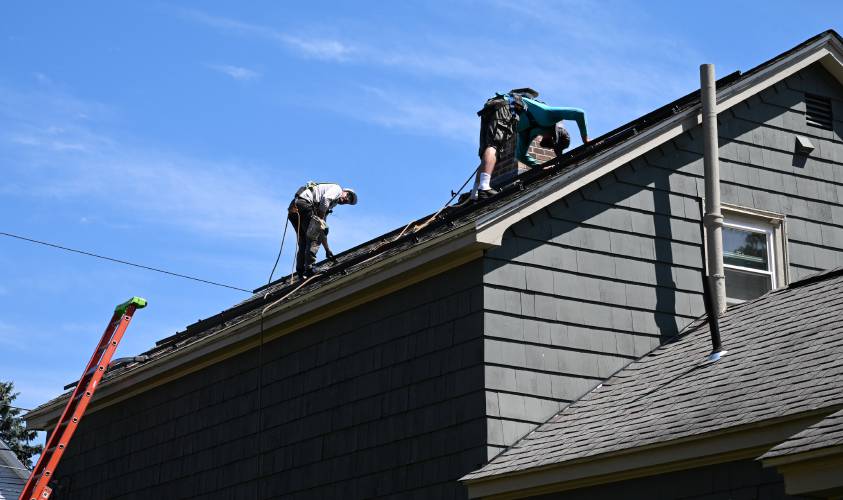Regional solar installers say tax credit cuts may delay payback
| Published: 07-28-2025 2:40 PM |
EASTHAMPTON — While federal cuts to solar energy tax credits in the “One Big Beautiful Bill Act” may lengthen the time it takes for home and business owners to pay back solar projects, local solar companies are confident that solar installations remain great investments.
The bill, which President Donald Trump signed into law on July 4, incorporates multiple provisions to clean energy, including solar. The most significant of those changes drastically shortens the length of time people and businesses can get a tax credit for solar installations.
Homeowners have until the end of this year to take advantage of a 30% tax break on residential solar projects. This new rule replaced tax credits in the Inflation Reduction Act of 2022 that gave homeowners tax incentives through 2034, with a gradual reduction starting in 2032.
“For PV Squared, it’s hard to say today exactly how this will affect our business, but the bill certainly introduces more complexity and uncertainty into an already challenging planning landscape,” Kate Carter, a member of management at Greenfield-based PV Squared, wrote in an email. “Even with the recent loss of federal tax credits, going solar in Massachusetts still makes strong financial sense.”
According to the Boston-based company EnergySage, a high-end project to install a 11-kilowatt array on a home in Massachusetts would cost about $32,500, and would be reduced to $22,750 through the federal tax credit, saving roughly $9,750 through the pay-off period. The amount of the credit depends on factors including the cost of a homeowner’s electric bill, the type of solar panel unit and changing market rates.
Homeowners who want the tax credit but won’t finish a project by the end of the year have one other option. They can enter a third-party ownership arrangement that allows a separate business to own the solar project and sell the power made from the array back to the homeowner, allowing homeowners to access the credit until the end of 2027, according to solar.com.
“A lot of the energy business has been driven with the mindset of incentives,” explained Gregory Garrison, president of Northeast Solar in Hatfield. “The consumers out there have an idea that solar has incentives and without incentives it is not as good of a purchase or an investment, which is not true. It’s just a matter of communicating details back to the client.”
According to Cornell Law School, solar electric property expenditures are “an expenditure for property which uses solar energy to generate electricity for use in a dwelling unit located in the United States and used as a residence by the taxpayer.”
Article continues after...
Yesterday's Most Read Articles
 Keeping Score with Chip Ainsworth: UMass hockey girds for new campaign
Keeping Score with Chip Ainsworth: UMass hockey girds for new campaign
 My Turn: A rocky road ahead for Stone Farm Lane proposal
My Turn: A rocky road ahead for Stone Farm Lane proposal
 ‘There’s always people you know here’: Bernardston’s Scarecrow in the Park brings community together
‘There’s always people you know here’: Bernardston’s Scarecrow in the Park brings community together
 Speaking of Nature: A surprise in my maple tree: Porcupines just want to find something tasty to eat and be left alone
Speaking of Nature: A surprise in my maple tree: Porcupines just want to find something tasty to eat and be left alone
 Greg Franceschi: Support bike lanes and walking paths in South Deerfield
Greg Franceschi: Support bike lanes and walking paths in South Deerfield
 Lowest bid comes in at less than $6M for Deerfield’s 1888 Building project
Lowest bid comes in at less than $6M for Deerfield’s 1888 Building project
Similar to the residential tax credit, businesses under Trump’s new bill must begin construction of solar installation by July 4, 2026 to qualify for the 30% tax credit. If construction does not begin before then, solar projects must be in service and operational before Dec. 31, 2027 to access the credit.
National impactAt a national level, the bill is expected to have a large impact because solar energy cuts are likely to reduce the number of solar factories and manufacturing sites. A recent analysis by the Solar Energy Industries Association reports that in its current state, the bill could result in the loss of 330,000 jobs across the country, with 6,100 jobs lost in Massachusetts.
While local solar energy companies expect business will slow down, they maintain a firm belief that solar energy is still a reliable investment for homeowners.
“Yes, we expect the proposed cuts to have an impact — particularly on members of our community who are trying to go solar,” Carter wrote in an email. “Homeowners with marginal solar sites or those who need significant electrical upgrades may find it more difficult to move forward with projects without the full support of federal tax incentives. … While the removal of the tax credit may extend the payback period for some projects by a few years, solar still delivers significant savings over time.”
Solar energy demand has been on the rise in the country over the past decade. According to a 2025 report from the Solar Energy Industries Association, in the last decade, solar deployments across the nation have experienced an average annual growth rate of 28%.
In Massachusetts for 2023, renewable energy resources provided 34% of the total in-state electrical generation, with the largest portion coming from solar energy. In the same year, small-scale photovoltaic systems accounted for two-thirds of the state’s total solar electricity generation, according to the U.S. Energy Information Administration.
“I would say with solar, especially in Massachusetts, losing the tax credits is going to slow the progress of solar down some, but in general it’s still a very valid investment for homeowners,” said Michael Hempstead, president and co-owner of Valley Solar in Easthampton. “Nationally it’s going to have a very profound impact because there are states that have electric rates that are less than half of what ours are [in Massachusetts]. If you’re in a state such as that, trying to sell solar may be more expensive than the prevailing electric rates — that’s a problem.”
Valley Solar has been active in Easthampton for 10 years. Hempstead explained that over the past 15 years in Massachusetts, electricity prices increased due to the rising costs of natural gas, along with other reasons. According to the U.S. Bureau of Labor Statistics, in October 2015, the average cost of electricity for Boston-area households was 17.7 cents per kilowatt-hour (kWh), rising to 30.2 cents in October 2024, nine years later.
“We expect it’s going to have somewhat of a slowing effect on our business because instead of being a five-year payback it might be a seven-year payback,” Hempstead said. “In general we think that for a lot of people, not everyone, it will still be a very good investment.”
State incentivesHempstead explained the spike in demand for solar energy over the past decade can be partly attributed to the introduction of state programs including the first Solar Renewable Energy Certificates (SREC) launched in 2010 and the Solar Massachusetts Renewable Target (SMART) program launched in 2018, along with decreasing costs to solar equipment and installation costs.
More recent energy legislation in Massachusetts occurred earlier this year. On June 20, the state Department of Energy Resources (DOER) filed emergency regulations for the SMART 3.0 program. The regulations aim to “create a sustainable incentive program that advances solar energy in Massachusetts while being able to quickly respond to changing market conditions.”
“Solar is one of the fastest and cheapest forms of energy we can bring into Massachusetts right now,” Gov. Maura Healey said in a statement in June. “I want us moving as fast as states like Florida and Texas on this because it will increase reliability and bring down the cost of electricity. Our administration is moving quickly to reduce costs — that’s why we released our Energy Affordability Agenda and filed legislation to get charges off bills and support the growth of new energy.”
“We do anticipate there will be some drop-off in business, but overall we still feel and it is well-documented that solar is still the cheapest form of energy a household can purchase,” Garrison said. “Our focus is primarily on retaining 100% of our team, continue to grow our business and to be a good partner in the communities. We’ve been here now for 15 years and we have a great reputation with the [Pioneer] Valley and western Mass.”
Garrison explained that due to permitting, planning and design processes, solar projects take months to fully contract and construct. With Northeast Solar nearly fully contracted until the end of the year, he believes that most solar energy companies will have an idea of how the tax credit cuts will impact sales sometime in October, when 2026 sales can be compared to 2025.
“It’s truly unfortunate that the government decided to disincentivize the one thing that was providing the best return for homeowners through the tax credit,” Garrison said. “The way our company always looked at it was that those tax credits came through the federal government but they came to our communities, and those households were able to use the savings of their energy dollars to invest more in their communities.”
Sam Ferland can be reached at sferland@gazettenet.com.














 South County Notebook: Aug 17, 2025
South County Notebook: Aug 17, 2025 Mohawk Trail students to see new staff, new codes of conduct upon Aug. 27 return to school
Mohawk Trail students to see new staff, new codes of conduct upon Aug. 27 return to school Grand opening of Buckland-Shelburne Elementary School playground set for Aug. 26
Grand opening of Buckland-Shelburne Elementary School playground set for Aug. 26 Bear-y unwelcome: Why MassWildlife says it’s time to ‘break up’ with bird feeders
Bear-y unwelcome: Why MassWildlife says it’s time to ‘break up’ with bird feeders
